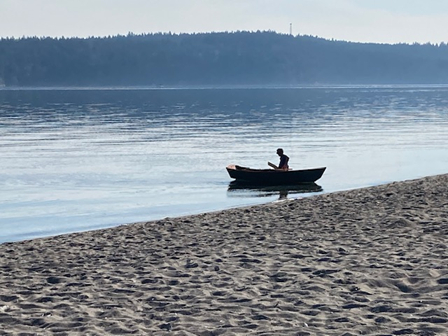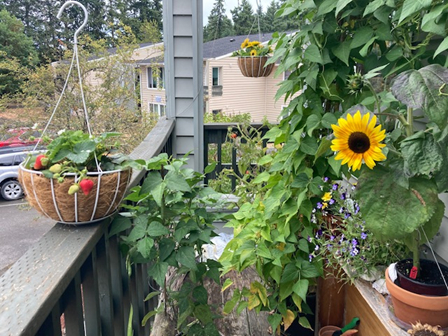
Home >> Newsletters > GreenFriends Newsletters > Q1 2024 Newsletter
| Home | Source Reduction | Friends of Green Friends | Newsletters |
| Gardening | Resources | What You Can Do | Embracing The Trees |
| On Nature Deficit Disorder |
 |
|
There is a lot of talk nowadays about the changing climate and decreasing biodiversity, but some of the information comes in the form of scientific literature which can be quite unapproachable. These publications assume that we want to preserve our current ecology, but how many people know how to preserve our ecology, from a practical standpoint for everyday living? There is often a disconnect between big picture concepts in the natural sciences and an actual individual experience of the natural world. The term "Nature Deficit Disorder" (NDD) was coined by Richard Louv in his 2005 book, Last Child in the Woods, in which he described a state of alienation many people experience from the natural world beginning at a young age. NDD is not a scientific diagnosis; it is referencing Attention Deficit Disorder (ADD) to imply that people are not paying attention to the world outdoors, nor do many even know how or why this might be important. This lack of awareness is detrimental not only to nature but to our quality of life. There are many mental and emotional benefits to spending time outdoors. Fresh air, sunlight, and wide-open places help reduce anxiety, depression and stress. While activities such as bird watching, climbing trees, walking by a stream or catching bugs, improve motor function and physical ability in children and adults, other activities in nature such as camping and hiking, keep us healthy and strong. Inner city children, for example, are known to benefit from experiences in nature, away from the city. A week of river rafting or outward bound training for at-risk-teens often helps heal their emotional wounds. When back in the city, these children are more likely to pay attention to and want to protect the local flora and fauna—even the raccoon or a bat family tucked up under exterior rafters. |
 |
|
There are many different ways of evaluating NDD in terms of qualities and activities. A study by Treehugger revealed that across the US, prisoners are guaranteed two hours of outdoor time a day, while too many kids these days are spending only one hour outside. There is a stark difference between the types of activities and facilities these two groups have for choices in their time outdoors. Prisoners might have a chance to play sports during their 2-hour time in the prison yards, and they have a chance to feel the sun and breeze on their faces. However, the prison yards are drab and with high walls and barbed wire all around and the danger of fights breaking out. But at least inmates have the chance to see blue sky, clouds, the occasional daytime moon, and even some insect activity. Inmates have noted that this time outdoors has a positive emotional and mental impact. On the other hand, many children who have the freedom to be outside after school hours, and who have the opportunity to spend hours playing or practicing sports, opt to spend an average of only one hour a day outdoors. All too often, children prefer to spend time inside playing computer games or glued to the TV. Treehugger suggests that it would be well for schools to get involved, by increasing mandatory time spent outside on school playgrounds. Studies in Finland have shown that the more children play, the better they perform in school and that teens do better on scores. The time we allot for kids getting together for spontaneous play, making up rules on the spot or going exploring in nature, is critical for their development, according to the American Psychological Association (APS). The APS describes unstructured play time as " . . a fundamental necessity for children to thrive physically, emotionally, mentally and socially." It is in the unstructured outdoor playtime in the hills, forests, or arroyos of the desert, that children have the chance to let their imaginations soar. At the same time, they have a chance to revel in the innate beauty of nature. However, many kids are only spending seven minutes of their time a day engaged in unrehearsed play, according to a report from the University of Michigan’s Institute for Social Research; this unstructured play time is down 50% over the last 20 years alone. Where is our time spent for both adults and children? It should be no surprise that one of the biggest sinks of our attention is electronic devices with internet access, also known as connected tech. This problem is not limited to children alone, with data from DataReportal showing that globally, adults spend just under seven hours a day looking at screens, which is around 40% of our waking day. Almost all of this time is spent indoors on work and leisure; a survey conducted by the National Human Activity Pattern all the way back in 2001, determined that US adults spent 93% of their time indoors or in their car. NDD is a symptom of deeper underlying cultural issues surrounding our increasingly urban lives. But if we want to heal ours and our children’s connection with nature we have to start with our inner child. Amma often tells us to become innocent like a child. Watch a child playing in nature, and then remember your own childhood and times you might have gone camping or on a picnic. Remember the joy of it, the abandon you felt while chasing a butterfly or trying to catch the dog who’s running after a rabbit. Or maybe, as Amma often describes, you might remember playing king and queen in a royal court in the forest. Our inner child is always available to us; we only need to remember and then go out and experience nature with child-like fascination and care. |
 |
| But where can we access nature? Paradoxically, we often regard nature as something that exists far from cities in an untouched and pristine state, like one of the National Parks or Forests. This mindset of a generally inaccessible natural world has contributed to our lack of awareness. The world of animals and plants is teaming within our cities. Species like racoons, frogs, crows, rats, coyotes, pigeons and many other birds, sometimes are regarded as pests, but they have adapted to our urban environments.
At night some of these species come out to forage away from our prying eyes, but they live among us nevertheless. They can teach us a lot about nature, if not more so than the bears, deer, and eagles of the Sierras, because they’re our local neighbors. We can observe them and their behaviors on a daily basis. Have you ever heard the coyotes howling at night? Or the haunting sound of a loon, if your city is near a lake? Or found a frog in your planter? It can be a great joy to spot a bird's nest in a tree in your local area. A space as small as a front yard or neighboring lot can host an abundance of plant species that support innumerable insects and an assortment of birds. While these spaces are not distributed equitably across our cities, they can serve to raise awareness of the natural world, which would make the occasional or one time visit to a National Park such as Yellowstone or Yosemite even more rich. And if you don’t have any exterior space, a single house plant in a window that you care for is still a valuable connection to foster. In whatever way you can rouse your inner child to behold and remain in awe of the natural world, which is all around us and inside of us, is certain to bring invaluable expansion of consciousness on all levels. The single greatest thing keeping us apart from nature is our belief or our lack of experience. Human exceptionalism has been the dominant worldview for a few hundred years now, and it has led us to a fabulously high tech world with very little spiritual regard for the countless other beings that we share this planet with. As Amma has repeated again and again, technology should serve nature and not the other way around. The remedy to many of the anxieties we feel about our changing climate and resultant stressful lives is to think globally and act locally. To heal the planet, we’re going to have to start in our own hearts, homes, and communities. Any small steps we take to raise awareness and care for plants and animals will lead us to changes to build a better world for all. As Amma says, "Don't be discouraged by your incapacity to dispel darkness from the world. Light your one candle and step forward." Leander McNeely and GreenFriends North America Team |
Read about the Amazon's Devastating Drought in the Q1 2024 newsletter
| Home | Source Reduction | Friends of Green Friends | Newsletters | Resources | What You Can Do | Embracing The Trees |
For more information, e-mail info@greenfriendsna.org |
||||||